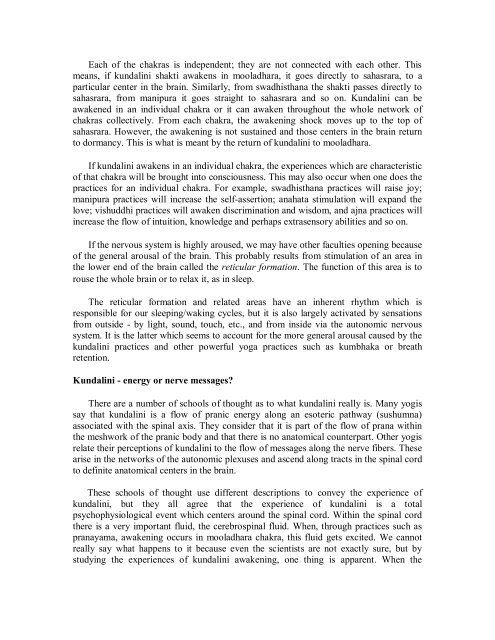Kundalini.Tantra.by.Satyananda.Saraswati
Create successful ePaper yourself
Turn your PDF publications into a flip-book with our unique Google optimized e-Paper software.
Each of the chakras is independent; they are not connected with each other. This<br />
means, if kundalini shakti awakens in mooladhara, it goes directly to sahasrara, to a<br />
particular center in the brain. Similarly, from swadhisthana the shakti passes directly to<br />
sahasrara, from manipura it goes straight to sahasrara and so on. <strong>Kundalini</strong> can be<br />
awakened in an individual chakra or it can awaken throughout the whole network of<br />
chakras collectively. From each chakra, the awakening shock moves up to the top of<br />
sahasrara. However, the awakening is not sustained and those centers in the brain return<br />
to dormancy. This is what is meant <strong>by</strong> the return of kundalini to mooladhara.<br />
If kundalini awakens in an individual chakra, the experiences which are characteristic<br />
of that chakra will be brought into consciousness. This may also occur when one does the<br />
practices for an individual chakra. For example, swadhisthana practices will raise joy;<br />
manipura practices will increase the self-assertion; anahata stimulation will expand the<br />
love; vishuddhi practices will awaken discrimination and wisdom, and ajna practices will<br />
increase the flow of intuition, knowledge and perhaps extrasensory abilities and so on.<br />
If the nervous system is highly aroused, we may have other faculties opening because<br />
of the general arousal of the brain. This probably results from stimulation of an area in<br />
the lower end of the brain called the reticular formation. The function of this area is to<br />
rouse the whole brain or to relax it, as in sleep.<br />
The reticular formation and related areas have an inherent rhythm which is<br />
responsible for our sleeping/waking cycles, but it is also largely activated <strong>by</strong> sensations<br />
from outside - <strong>by</strong> light, sound, touch, etc., and from inside via the autonomic nervous<br />
system. It is the latter which seems to account for the more general arousal caused <strong>by</strong> the<br />
kundalini practices and other powerful yoga practices such as kumbhaka or breath<br />
retention.<br />
<strong>Kundalini</strong> - energy or nerve messages?<br />
There are a number of schools of thought as to what kundalini really is. Many yogis<br />
say that kundalini is a flow of pranic energy along an esoteric pathway (sushumna)<br />
associated with the spinal axis. They consider that it is part of the flow of prana within<br />
the meshwork of the pranic body and that there is no anatomical counterpart. Other yogis<br />
relate their perceptions of kundalini to the flow of messages along the nerve fibers. These<br />
arise in the networks of the autonomic plexuses and ascend along tracts in the spinal cord<br />
to definite anatomical centers in the brain.<br />
These schools of thought use different descriptions to convey the experience of<br />
kundalini, but they all agree that the experience of kundalini is a total<br />
psychophysiological event which centers around the spinal cord. Within the spinal cord<br />
there is a very important fluid, the cerebrospinal fluid. When, through practices such as<br />
pranayama, awakening occurs in mooladhara chakra, this fluid gets excited. We cannot<br />
really say what happens to it because even the scientists are not exactly sure, but <strong>by</strong><br />
studying the experiences of kundalini awakening, one thing is apparent. When the














![[Lonely Planet] Sri Lanka](https://img.yumpu.com/59845622/1/169x260/lonely-planet-sri-lanka.jpg?quality=85)


